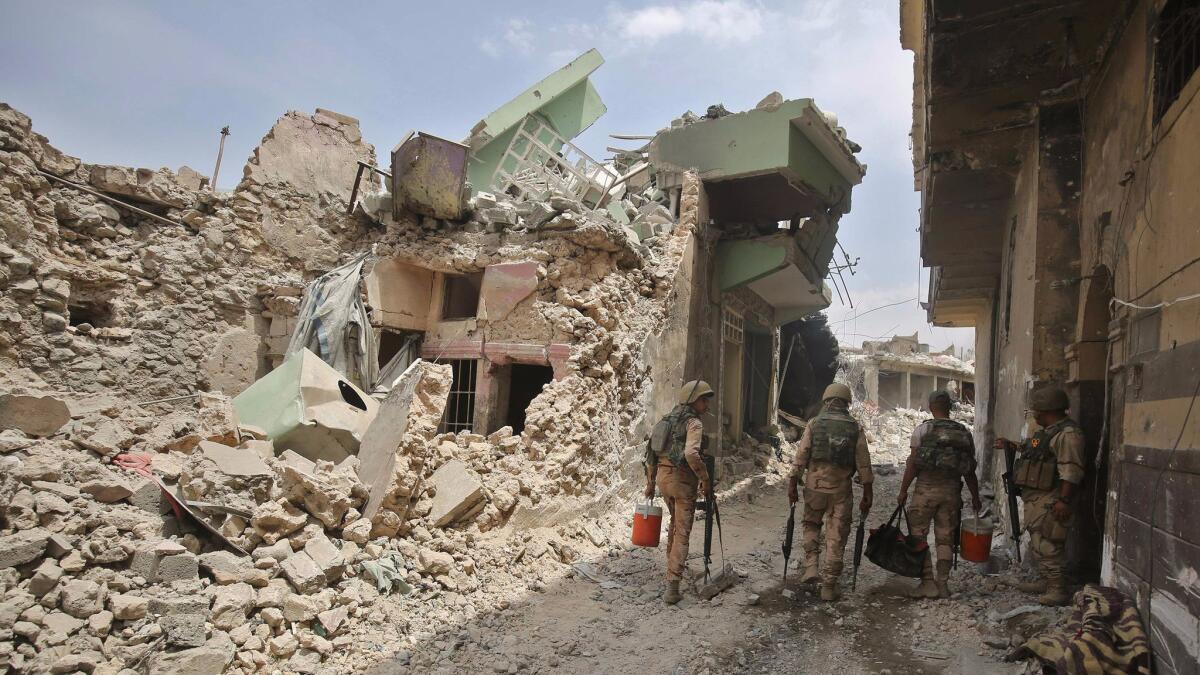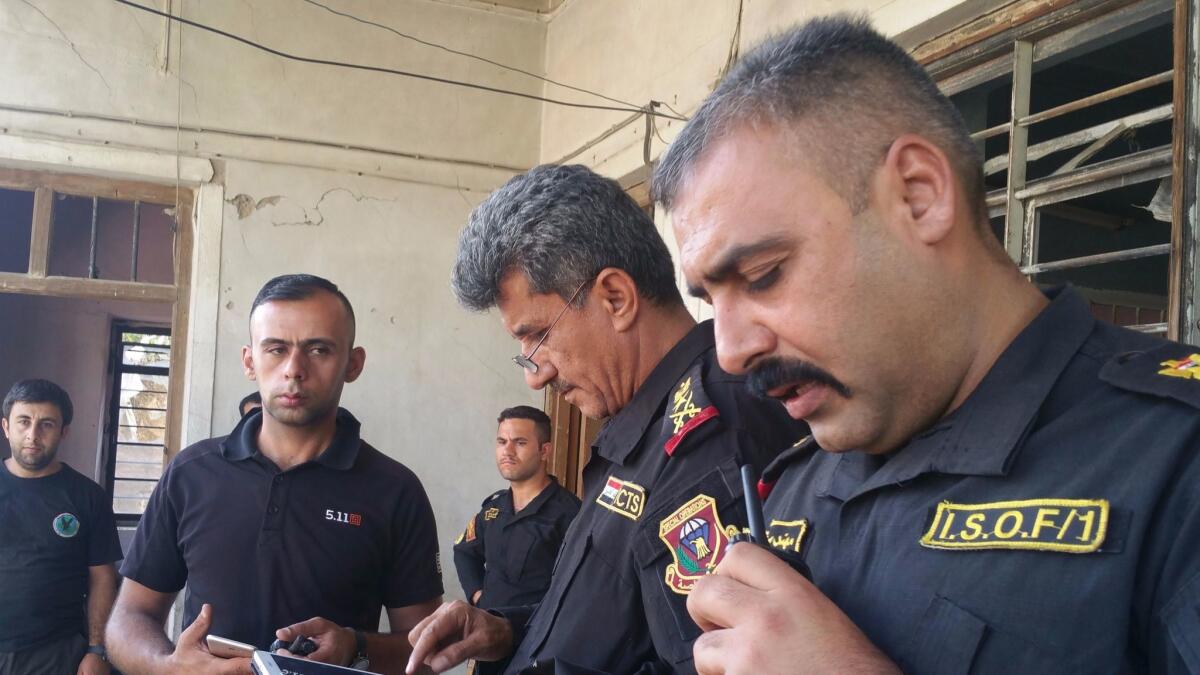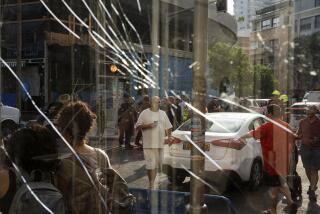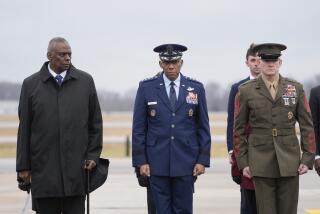For Iraqi soldiers coordinating coalition strikes on Islamic State, it’s a different kind of war

Reporting from Mosul, Iraq — The two Islamic State jihadis scrambled up to the roof of the building, breaking cover for a moment before quickly hiding from sight. But it was too late. They had been spotted by the camera drone hovering above Mosul’s Old City, their images beamed to black-clad special forces operatives huddled around a tablet roughly 300 yards away.
Lt. Col. Muhannad Tamimi, a battalion commander, turned to his walkie-talkie. “Staff Col. Arkan,” he said. “Staff Col. Arkan, two militants on the roof. Strike. Record these coordinates.” Tamimi pinched the screen of the tablet, then recited a string of numbers off the smartphone in his other hand.
“Received,” came a voice from the radio.
That message set in motion a response that would materialize minutes later in the form of a shriek and a ground-shaking boom — yet another coalition airstrike directed by Col. Arkan Fadhil, 36, and his team from Iraq’s Counter-Terrorism Service.

Known as Joint Terminal Attack Controllers, or JTACS, the team is playing a vital role coordinating and directing the coalition’s air support in the Iraqi government’s long campaign against Islamic State. Watching JTACS in action also serves as a reminder that the offensive against Islamic State involves a coalition of Western governments.
One recent morning, as dawn lightened the skies above west Mosul, Fadhil reported to a house on the city’s edge, some 2 miles from the front line. On a wall hung a large satellite map of the Old City. Blue symbols, set a small distance from markings posted a day earlier, showed the troops’ torturous advance into Islamic State’s last redoubt in Mosul.
A heavy barrage had already begun when the JTAC team parked two Humvees bristling with antennae by the house’s side and set up a command center. Two hulking M-RAPs, armored trucks used by the coalition, rumbled to a stop at an adjacent house.
“Good morning, sunshine,” said Fadhil in English to an Australian officer, who grinned in response as he shook Fadhil’s hand.
His battalion would be working with the Australians, but different coalition members are assigned to work with other units in Iraq’s security forces. Fadhil spoke with an easy drawl, giving a passable impression of an Iraqi Tom Cruise circa “Top Gun” — a result of his time in America training with the Rangers and gaining the skills he now discussed with obvious pride.
He recalled the first time he directed a coalition strike in July 2015. Like everyone around him, he spoke in abbreviations and acronyms.
“It was on this VBIED in Ramadi. I saw it coming at us,” said Fadhil, flashing a boyish grin. He used the abbreviation for “vehicle-borne improvised explosive devices”: in other words, car bombs — one of Islamic State’s signature weapons.
“All the commanders were watching me calling it in, and then I got it. It was great,” he said.
Fadhil entered one of the Humvees and settled before an array of communication devices and displays. One display glowed with the words “Arkan Angel,” a reference to Archangel, his call sign.
“There’s some hostile fire coming from this building,” said a voice on the radio in Arabic, relaying a string of coordinates.
It marked the opening move in Fadhil’s almost ascetic brand of combat, one dictated by numbers and audio broadcasts, and where the sounds of war would only occasionally intrude.
Two Islamic State teams, one armed with rockets and the other with machine guns, were holding back the day’s advance. Fadhil consulted his tablet, then relayed the information to his Australian counterparts.
“RPG team and MMG team 1-5-0-9,” he said.
The Australians then directed coalition warplanes to “positively identify” the target — forces armed with rocket-propelled grenades and a medium machine gun.
“We won’t just drop a bomb on everything that’s called in. We have to check every target to the last second of the execution of the mission and confirm there are no civilians near it. … Then we hit it,” explained Fadhil.
“It sounds like a long process, but it’s minutes.”
A voice with a thick Australian accent interrupted Fadhil.
“RPG and MMG 1-5-0-9. And I’ll let you know if we can work anything out for that second MMG,” said the voice.
Until the second target could be confirmed, Fadhil responded, he’d request an artillery strike on another position.
Though Fadhil and his team had dozens of engagements with Islamic State under their belt — the Counter-Terrorism Service has spearheaded most of the government’s offensives against the group — they face an especially difficult time in the Old City quarter, home to anywhere from 100,000 to 150,000 people, according to U.N. estimates. Hidden among them are some 400 militants, who vowed to make a last stand in the one-time capital of their “caliphate.”
The militants had more than three years to prepare for the government’s assault and knocked holes into the walls of buildings, transforming the district into a labyrinthine network of “wormholes” and shroud-covered walkways to conceal their movements from reconnaissance drones.
The jihadists also have turned residents into human shields, coercing them to hide in buildings they use as military positions, coalition and Iraqi commanders say. Fadhil recalled an incident in May, when three strikes on West Mosul’s Seha neighborhood were called off.
“We were all good to go, and we couldn’t see any civilians on our [reconnaissance] platforms. But soldiers on the ground saw them,” he said. “They immediately reported it and the hits were canceled.”
But it doesn’t always work that way.
The U.S. military acknowledged that on March 17 hundreds of civilians were killed in an air raid on a building commandeered by two Islamic State snipers in the Jadidah neighborhood of west Mosul. A Pentagon investigation blamed the deaths on explosive materials stored inside the building.
Fadhil insisted that the attack had been done “by the book.”
“It was a legitimate target … but if anyone through the approval priority — from the guy on the ground to the highest — if they had a 1% chance of knowing there were civilians there, they would have called it off,” he said.

The number of civilians killed in military actions against Islamic State is a point of dispute between the Pentagon and human rights groups. The Pentagon puts the number of deaths in the hundreds. Some human rights groups say that, since 2014, thousands of civilians have been killed in Syria as well as Iraq in fighting against the militants.
Though Fadhil has the authority to approve strikes himself, he explained that certain targets, such as bridges and other infrastructure, need more approval. Other units, such as the Iraqi army’s 9th Division, has U.S. servicemen assessing strike information alongside Iraqi commanders.
The close-quarters combat in the Old City quarter means some of the hardest calls Fadhil makes are what he called “danger close-fire missions.”
“That means the strike is very close to our forces, so it’s very dangerous,” he said. As if on cue, the Humvee door opened. One of Fadhil’s JTACs asked him if he could “push” a strike on a position a mere 40 yards from the advancing Iraqi troops.
Fadhil paused for a beat. “Sure,” he said, giving a slight nod before turning to a visiting reporter and smiling.
Back on the front line, Tamimi, the special forces commander, squinted at the tablet used to direct the attack on the two militants hiding on the roof. A puff of smoke now dominated the screen where the building with the militants had stood.
“Tamat al muaalajah,” he radioed to his men up ahead. Strike complete. He made the comment matter-of-factly, without emotion.
“There’s no more hostile fire from that building. Advance.”
Bulos is a special correspondent.
Twitter: @nabihbulos
ALSO
Protesters outside G-20 summit violently confront riot police in port city of Hamburg
Filipinos watch in horror as their city is destroyed in fight with Islamic State affiliate
Building by booby-trapped building, students work to reclaim Mosul University
More to Read
Sign up for Essential California
The most important California stories and recommendations in your inbox every morning.
You may occasionally receive promotional content from the Los Angeles Times.











